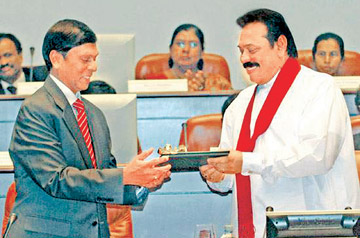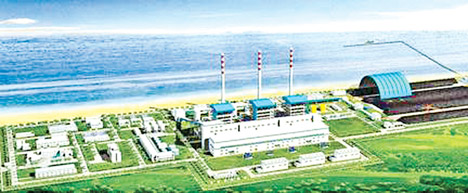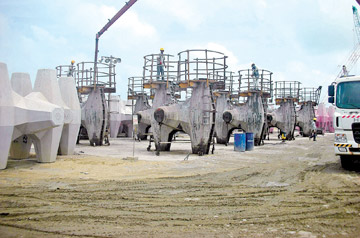|
Lanka's economy in upward swing:
People seek better things in life - Central Bank Governor
By Shirajiv SIRIMANE
The Sri Lankan economy is showing signs of an upward trend with the
buying power of people increasing. A motor cycle is sold every minute
and a three-wheeler every three minutes, clearly indication that people
are looking for better things in life.
Governor Central Bank, Ajith Nivard Cabraal told the Sunday Observer
that the quality of life of Sri Lankans is improving and they are on the
look out to move up the social ladder.

|

Central Bank Governor Ajith Nivard Cabraal presents the new
currency note |
"Today Sri Lankans are looking at convenience, better things in life,
and most importantly quality. This is the reason for the success of
super market chains in the country today. Just see how many super
markets are opened every month; this clearly shows the demand for
quality living among the people", he said.
"See how many houses are being built. Most people who used to walk or
cycled are today having a three-wheeler, motor cycle or some sort of
vehicle of their own".
He said five years ago there were only five six television channels;
today one can view over 50 channels. The hospitality advertisements in
the Sunday News papers are a mirror as to how much people are travelling
both locally and overseas.
The perfume and powder imports to the country last year were worth
Rs.5 billion which also proves that people are looking at the finer
things in life.
The Government is playing a lead role in providing infrastructure and
for the first time in the history of the country, five harbours are
being elevated to international standards with three new harbours being
built.
The first international harbour to be added to the Sri Lankan
maritime sector is the Ruhunu Magampura Harbour in Hambantota while
Oluvil is the second new international harbour which would be opened by
the end of the year.
Another crying need of the maritime industry for the past 20 years,
the extension of the Colombo port, too is now being carried out. In
addition, both Colombo and Galle are to be upgraded to international
standards to meet the future needs of the tourism and cargo industries.
Cabraal said the Commonwealth Games bid too is now gaining momentum
and the infrastructure that is being put in place would elevate
Hambantota to one of the most planned cities in the region.
The model plan for the Commonwealth Games is well designed, ensuring
that the infrastructure that is being readied for the Games would be
fully used even afterwards.
The Games Village would later be converted into an IT park and there
would also be an economic zone.
|

Norochcholai power project |
An IT campus too would be built while several other BPO firms have
already shown an interest in investing in this area. "Every country has
to build its brand names after going through a lean stretch such as a
natural disaster (tsunami) or war (by the LTTE). For Sri Lanka the brand
building exercise comes from the Commonwealth Games", he said.
Sri Lanka received major recognition as a middle income country when
the International Monetary Fund (IMF) upgraded the island into its
Middle Income Emerging Markets segment in its latest listing in January
2010.
Sri Lanka will now be recognised as a country with a 'Middle Income
Emerging Market' status with the IMF promoting Sri Lanka from the list
of Poverty Reduction and Growth Trust (PRGT) eligible countries on
January 11, 2010.
|

Hambantota harbour |
IMF upgrade
This upgrade would facilitate Sri Lanka to project itself strongly in
international financial and capital markets.
He said the per capita income of Sri Lanka too has shown a sharp
increase and augurs well for the country. Sri Lanka's per capital income
is at US$ 2,399 and is expected to double in four years. He said the
maritime, aviation, knowledge, commerce, and energy sectors would play a
key role in taking the country in this direction.
The Central Bank Governor said that people are expecting instant
results in some projects such as the Hambantota Magampura Port.
He said that projects such as Norochcholai and Upper Kotmale were in
the pipeline for over 20 years and had they being expedited, Sri Lanka
would have enjoyed more benefits.
today Sri Lanka's inflation rate is under seven percent and would be
maintained at those levels.
He said the Government always encourages local investments and this
is now happening as the Diaspora is investing in Sri Lanka. He disclosed
that Sri Lanka had an all time record of US$ 227 million of foreign
direct investments in the first quarter of this year. "We expect this
trend to continue", he said.
He said this was achieved despite negative publicity created by LTTE
sympathisers who try to create a bad image of the country in the world.
"Don't expect instant results as all these projects are for the
future" he said.
|

Colombo Port development |
Commenting on the country's debt, he said that borrowing is needed
for any country to develop. "I can say with authority that the debt is
manageable".
Global economic downturn
The Governor said when the world was facing an economic downturn, Sri
Lanka was able to keep its head high which clearly shows the island is
financially stable.
Commenting on Sri Lanka's export earnings Cabraal said it will reach
US$ 10 billion during this year. "Export earnings in January increased
by 72.4 percent year-on-year to record US$ 813 million, led by
significant exports of textiles and garments and rubber products".
One of the biggest problems faced by the provinces was regional
disparity. The economic indicators were dominated by the Western
Province where all business was centred. However, with the Government
deciding to offer benefits to rural entrepreneurs and concepts such as
taking industries to villages, the gap is now narrowing. This is mostly
evident in the Northern province with was battered by LTTE terror for
almost 30 years.
A fast recovery of economic activities is taking place in the
Northern Province since the end of the conflict in May, 2009. In 2009,
the Province recorded a provincial nominal GDP growth rate of 14.2
percent, the second highest in the island.
Sri Lanka's Northern and Eastern Provinces were badly affected by the
three decades of conflict that ended in May 2009.
|

Minister Basil Rajapaksa commissions a
project in the Eastern Province |
The LTTE, during its intensified fight, created many obstacles to the
Government's development initiatives.
The Eastern Province, which was liberated earlier, recorded the
highest growth of 14.4 percent. The economic performance of the Northern
Province in 2010 is expected to have improved further as peace prevailed
during the year.
Sri Lanka's GDP for 2010 reached an impressive eight percent growth
rate.
This GDP growth rate is the second highest recorded
post-independence, while the highest recorded rate was 8.2 percent in
1968 and 1978.
These positive figures are certainly taking the country closer
towards its goal of being the Wonder of Asia... |

